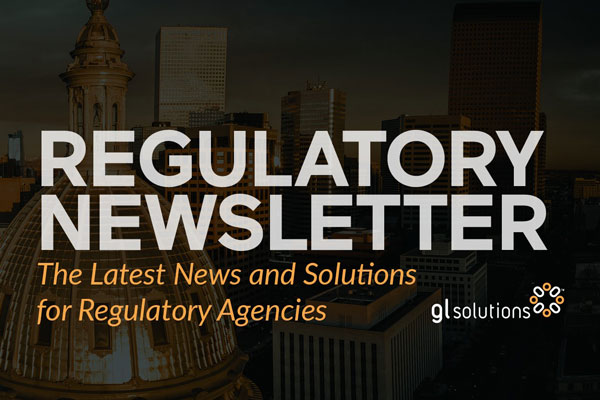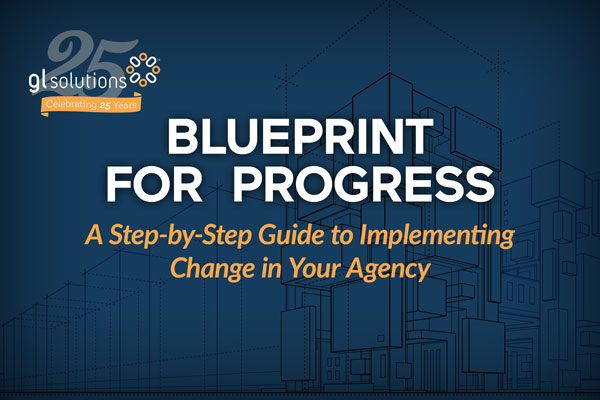According to a survey from the National Association of State Chief Information Officers (NASCIO), modernization ranks “top of mind” for state CIOs for several reasons. COVID revealed the weaknesses in legacy systems to meet regulatory obligations and consumer demand. Manual service delivery models failed to work to offer people assistance. And consumers now demand modern digital services. Along with these demands, the federal funds available to states create opportunities for states to modernize their applications. The current workforce shortage also necessitates doing more with less.
Discover a five-step process to transform your regulatory agency, modernizing to better serve the public—and support your staff. Digital transformation starts with your agency establishing the mission and vision for your agency. As you move through different phases of development, you gradually re-engineer your business processes—while supporting your agency’s workflow; your agency standardizes processes, promotes online self-service and embraces digital communication. Eventually, you move towards a model agency where your agency focuses on gathering data and measuring performance.
Step-by-step agency modernization gives your agency a pathway to:
- Make changes gradually—or dynamically.
- Re-engineer business processes.
- Use predefined milestones.
- Alleviate financial and staffing impacts.
Step 1: Build Capacity
In step 1, your agency not only grows capacity, but also capabilities. You acknowledge the issues your regulatory agency faces, including regulatory compliance management process and performance weaknesses.
Your agency defines clear and compelling objectives for your digital transformation—along with dates to meet those goals.
How Step 1 Looks: Advancing technology, along with your agency’s cybersecurity needs, push your agency onto the path of modernization. Your agency’s reputation and efficiency, along with the public’s needs and demands, depend on this.
You know you are at step 1, if you face these struggles:
- Disengaged staff
- Poor productivity
- Work backlog
- Employee insubordination
- Poor customer service
Action items for Your Agency:
- Establish agency mission and objectives.
- Evaluate leadership capacity.
- Create a plan to standardize processes.
- Identity a process standardization team.
- Assess staff engagement and performance.
- Replace actively disengaged employees.
Step 2: Standardize Processes
In step 2, you define your agency’s business processes. Before step 2 your agency struggles with poorly defined processes and little control of those processes. Your employees complete tasks in different ways, and sometimes fail to complete important steps.
“You have to know how your regulatory agency’s functions,” explains Bill Moseley, CEO of GL Solutions. “You can’t really automate workflow if you have no idea how you function.”
During process standardization, you define the right way to complete the work—and the right management solutions to use for that work. You create business process guides for your agency staff to follow in a step-by-step fashion. Your staff use vetted processes that follow best practices and meet regulatory compliance needs.
How Step 2 Looks: Your agency reviews the current systems and processes at your agency, determining how to bring them up to date and unifying them on a single set of processes.
You know you are at step 2, if you face these struggles:
- Data inconsistencies
- Data entry errors
- Redundant work efforts
- Staff inefficiencies
- Knowledge silos
- Trouble training new staff
- Information stored on paper
Action items for your agency:
- Create business process guides.
- Clearly define workflow.
- Use data interfaces.
- Develop reporting tools.
Step 3: Serve Customers
In step 3, your agency brings your public-facing permitting and licensing services online with regulatory software. Your customers expect the ability to interact online, so you transition to modern, public-facing websites and portals. You promote all public communication toward online self-service. This includes applications, permits, licenses, CE, background checks, enforcement, verification, status of licensure and claim status. In addition, agency websites should be mobile enabled to support data entry for remote functions, such as investigations, surveys and inspections.
You reduce your agency’s paper reliance and manual processes. With a constituent or licensee self-service online portal, your agency automatically feeds permitting and licensing data directly into regulatory software and systems to create electronic records.
Instead of sending out paper notices, for example, you automate that process, explains Moseley. “Notices go back and forth through an online portal, helping the public to communicate directly with the agency.” He offers the example of a daycare provider receiving notifications from the agency via that portal; in turn, the provider replies to that agency online, “automating the back-and-forth workflow between the public and agency seamlessly.”
Money-saving tip: Switching to a digital compliance solution not only uses less paper, but also saves money and supports customers. Read our interview with the Arizona Barbering and Cosmetology Board’s Executive Director Frank Migali to learn how he saved $60,000 by automating a licensing process. Migali expands on his return on investment with the switch from paper. “If we have happy customers, they’re going to come back. And they’re going to tell people about the great work that we’re doing and how quickly we process licenses and how easy that process is.”
How Step 3 Looks: Your regulatory agency employs customer-centric online capabilities, including online renewals, verification sites and a licensure verification portal.
You know you are at step 3, if you face these struggles:
- Arduous paper processing
- Large amounts of paper storage
- Application and renewal backlogs
- Staff inefficiencies
- High call volume
- Money wasted on stamps and shipping
Action items for your agency:
- Establish paperless office.
- Enable online self-service.
- Develop mobile-enabled websites.
- Employ DocuSign.
Step 4: Integrate Services
In step 4, your agency integrates the digital tools and portals you created in step 3; those systems enmesh, creating an integrated digital compliance management system. Communications, project and task management, documentation, review process and more all exist in a single integrated digital platform.
Your agency increases customer ease of use and transforms your field agents’ capabilities and response times with responsive and mobile friendly tools.
In addition, your regulatory agency uses online portals to facilitate communication. Niki Davisson, Technical Analyst for GL Solutions, gives the example of an agency that shares their corrective action plans (CAPs), by placing them in a client portal online in Key Components of a Case Management System. “The provider can see what regulations they violated,” explains Davisson, “and provide back the plan from the web to correct them based on agency feedback. The agency will accept that plan or provide additional feedback on what the provider needs to do and submit it back to the agency online.”
How Step 4 Looks: Your agency integrates your new standardized processes and customer-focused digital tools—and makes them mobile friendly, as well.
You know you are at step 4, if you face these struggles:
- Communication silos
- Redundant data entry
- Untraceable activity
Action items for your agency:
- Store all emails.
- Use staff dashboards.
- Implement communication portal.
- Enable mobile inspections.
- Use staff notifications.
Step 5: Improve Continuously
The NASCIO survey and report, Application Modernization is an Imperative, calls modernization a constant process. “Embrace that modernizing is not a single state and enable a continual process to make the applications that matter more reliable, accessible, and scalable.”
In step 5, your agency harnesses your experience and talents to continuously improve. Your regulatory compliance software gathers data, provides insights and measures performance improvements—automatically. Your agency reviews reports of these measures on a regular basis to help your agency improve. You serve as a model agency now—an agency that others reference as they tackle their own modernization efforts.
In step 5, you agency adds tools that measure performance, identify and resolve process exceptions, and demonstrate value to stakeholders. Add the analytics layer to the regulatory platform you built over the previous steps for automatic data collection and insights. For example, measure how your staff perform work, compared to others with a similar role. “At the very least,” explains Moseley, “management should be aware that there’s variation in how work is performed within the organization.”
Or get insights on where you experience a lot of deficiencies that perhaps require updating a form. Other advanced functions like batch processing come online and continue improving during this phase.
How Step 5 Looks: Your agency implements an analytics layer to your integrated and digital workflow, gaining real-time insights that power continuous improvement in permitting and licensing processes. Others state regulatory agencies look at your model agency to emulate.
You know you are at step 5, if you face these struggles:
- Lack of data performance measures
- No goals for improvements
Action items for your agency:
- Establish Key Performance Indicators.
- Monitor staff performance.
- Harness statistical data.
- Create agency dashboards.
- Business process dashboards
- Staff dashboards
- Plan continuous improvements.
Conclusion
Why follow a 5-step process?
Regulatory agencies need a strategic, building block approach to transform employee engagement, public safety and licensee satisfaction.
Agencies face new challenges:
- Managing a remote workforce
- Great resignation and staff turnover
- Meetings and workflow conducted across geographies
- Licensees accustomed to conducting every transaction on the web
- Legislators and public expecting lower regulatory obstacles
Architecting a model regulatory agency requires a steady, thoughtful and incremental approach. Agencies need resources, objectives, plans and partners to help them build their vision.
AI tip: For additional effectiveness and efficiency, integrate the power of AI into your transformation.
Need guidance on your modernization journey?
GL Solutions Agency Transformation service offers a revolutionary approach to true agency modernization— for current and new customers alike. Our regulatory experts give your agency a software application and roadmap to follow—one step at a time. Learn more on the Modernization page of our website.
Run, Grow and Adapt
Subscribe to our newsletter to receive the latest regulatory news delivered to your inbox each week.
GL Solutions helps governments run, grow and adapt. To learn more, explore our website, call us at 800.930.1193 or email us at hello@glsolutions.com.


